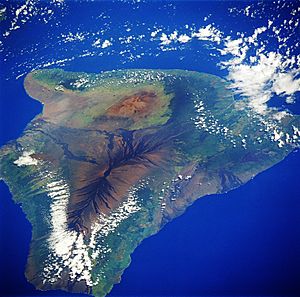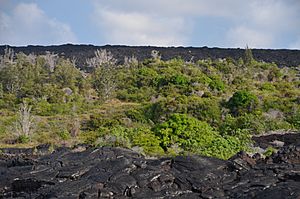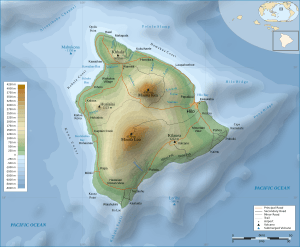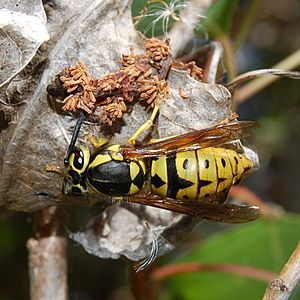Drosophila silvestris facts for kids
Quick facts for kids Drosophila silvestris |
|
|---|---|
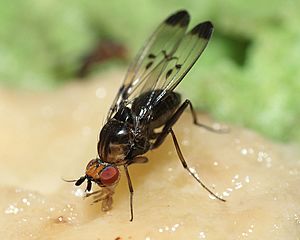 |
|
| Scientific classification | |
| Synonyms | |
|
Idiomyia silvestris Perkins, 1910 |
The Drosophila silvestris is a type of fly that is mostly black with yellow spots. It's a large fly with long legs and slim wings. This special fruit fly is only found in Hawaii (on "the Big Island").
Male D. silvestris flies do fancy dances and sing special songs to attract females. They also fight with other males to protect their space. Females choose their mates, which has led to males in some populations growing extra bristles on their legs over many years.
Contents
What Does D. silvestris Look Like?
D. silvestris flies have a round head, like most fruit flies. Female flies have a completely dark yellow or orange face. Males have a black face with a yellow stripe across it.
The antennae (feelers) are black on males and yellow on females. The sides of their bodies can be brown or black. Some flies also have yellow on the top edge of their bodies.
Male flies have two rows of long bristles on their front legs. In some areas of Hawaii (north and east), males have 20-30 extra bristles. These extra bristles form an irregular third row. They are important for the male's courtship dance. These bristles might have appeared because these groups of flies were separated from others.
This fly likes cooler weather and doesn't do well in heat. This is why they prefer cooler places high up in the mountains. Their bodies have changed over time to help them live at different altitudes.
Where Do They Live?
Hawaii is home to about 1,000 different kinds of Drosophila flies. D. silvestris lives only on the Big Island.
Lava flows from volcanoes create separate patches of land called kipukas. These are like islands of plants and trees surrounded by hardened lava. D. silvestris lives in cool, high-altitude rainforests. They can be found on the slopes of all five volcanoes on the Big Island: Mauna Kea, Mauna Loa, Kilauea, Hualalai, and Kohala. They usually live at heights between 900 and 1500 meters (about 3,000 to 5,000 feet). The oldest groups of these flies are found on Hualalai volcano.
How Did They Evolve?
A quarter of all the world's Drosophilidae species live only in Hawaii. They evolved from one original fly species that arrived 26 million years ago. Hawaii's many different plants and environments helped new species form. D. silvestris only lives on the Island of Hawaii, which is about 400,000 years old.
D. silvestris belongs to a group called "picture-winged" flies. There are 112 Hawaiian Drosophila species in this group, known for their unique wing patterns. D. silvestris is part of the planitibia subgroup. Flies in this group make courtship songs by vibrating their wings. D. silvestris and other newer planitibia species have simpler, higher-pitched songs than older species in the group.
D. heteroneura is a close relative of D. silvestris. Both flies live in Hawaii. They share similar genes, which shows they came from the same original group on Hualalai. But they look different.
One big difference is their head shape. D. silvestris has a round head. Male D. heteroneura flies have wide, hammer-shaped heads. This helps them in their head-butting fights. These head shapes might help females tell the two species apart when choosing a mate.
These two species often live in the same areas. However, D. heteroneura prefers the lower parts of rainforests, while D. silvestris likes higher altitudes. Scientists have seen both species sharing tree branches and laying eggs on the same plants. In a lab, they can have babies together. But in nature, they usually don't mate because of their different behaviors.
Mating and Territory
Lekking
Male D. silvestris flies gather in special spots called "leks." Females visit these leks to watch the males' courtship displays and choose a mate. This means that how well a male dances and sings can affect if he gets to have babies.
Males fight aggressively to control their territory. They spread their wings and legs, then walk towards each other. They bob their heads up and down. When they get close, they push each other backward. They also use their front legs to slash at each other. Bigger males tend to win fights, which might be why this species has evolved to be large.
Adult males choose a small, flat part of a tree fern or plant stem for their lek. These spots are usually 1.2 to 2.4 meters (4 to 8 feet) above the ground. Females come to these plants to feed and lay eggs. Males often choose spots under large trees to protect their leks from wind.
Sometimes, a male will be alone in his territory. Other times, several males might gather in a group. Up to ten males can share one shrub, each with his own spot. Adult males are easy to see, but younger males often hide. Females also stay hidden unless they are looking for a mate.
A male D. silvestris walks back and forth in his lek, waving his wings to attract females. These flies have good eyesight. Females can see the male's wing patterns to know if he is the same species. Males act aggressively towards any insect that enters their lek. So, when a female D. silvestris comes near, the male will act aggressively until he knows it's a female of his own kind.
Courtship
First, one of the flies (male or female) spreads its wings out to the side and waves them in a circle. Then, the male stands in front of the female. The female might slash at him with her legs. He will then circle around her. Finally, he stands behind her and puts his head under her wings for a moment. Then he vibrates his wings to make sounds. He also makes soft purring noises by bobbing his body.
Next, the male D. silvestris will rub his bristled front leg against the female's body. Then he tries to mate with her.
The extra 20–30 bristles on the legs of males from north and east Hawaii are a special feature. They show how important female choice is in their evolution. Since the island of Hawaii is less than 500,000 years old, these extra bristles are a fairly new change. Females from these newer populations will mate with males from both the new and old populations. But females from the older populations (in the south and west) will only mate with males who have just two rows of bristles.
Life Cycle
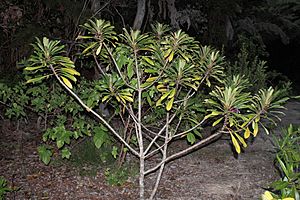
Female D. silvestris flies lay their eggs on the rotting or fermenting bark of certain plants. Their main host plant is Clermontia, a large shrub found in Hawaiian rainforests. They also lay eggs on Cyanea and Cheirodendron plants.
For females, their ovaries (where eggs grow) start to develop when they are in the pupa stage. But they don't fully mature until three weeks after they hatch from the pupa. Males also need time to mature after hatching, but they mature faster than females.
What Do They Eat?
Both young flies (larvae) and adult flies mostly eat the fermenting bark of Clermontia plants. This plant is bigger than other Hawaiian plants they might eat. Clermontia is the main food source for the planitibia group of flies. Newer species like D. silvestris have also started to feed on Cyanea and Cheirodendron. These plants are often found in the dense, lower parts of Hawaiian rainforests, near where the males set up their leks.
Who Are Their Enemies?
Vespula pensylvanica is a type of yellowjacket that is not native to Hawaii. It preys on D. silvestris and other Drosophila flies. This has caused a big drop in their numbers. Other enemies include insect-eating birds that live in Hawaii, like the Chasiempsis sandwichens.
Protecting D. silvestris
D. silvestris and other flies in Hawaiian rainforests are sensitive to changes in their home. Climate change is causing habitat loss as temperatures rise. This can affect where these rare flies can live and if they can survive.
Human activities like logging and farming also destroy their natural homes. Wild pigs, goats, and other animals eat their host plants like Clermontia. They also trample the ground, which harms the flies' habitat and food sources. When the ground is trampled, it also helps invasive plants grow, which can push out the native plants.
D. silvestris and other "picture-winged" flies are important for the Hawaiian rainforest ecosystem. They interact with host plants and other creatures. This makes them good indicators of how healthy the ecosystem is.


